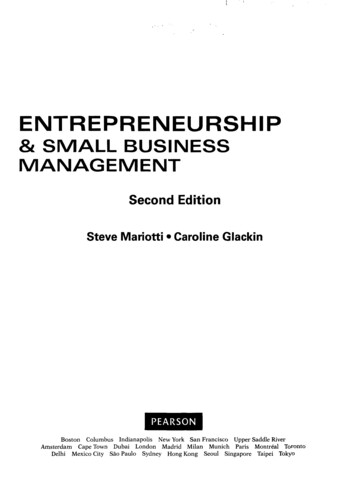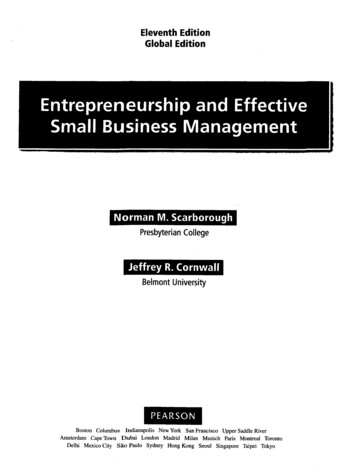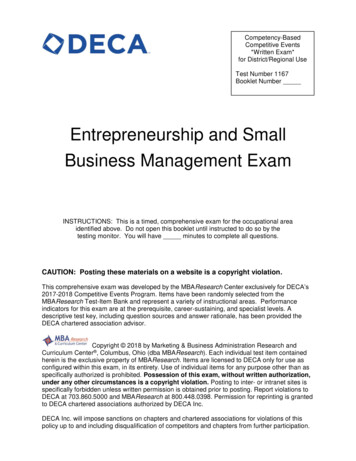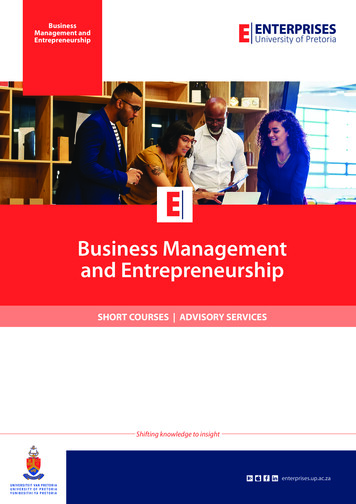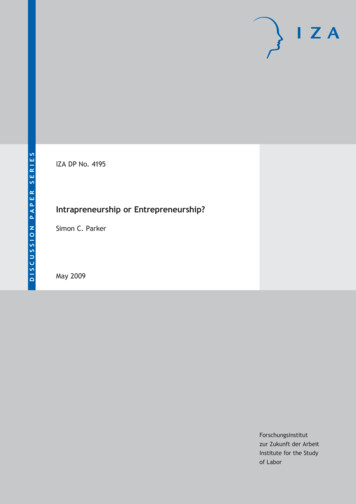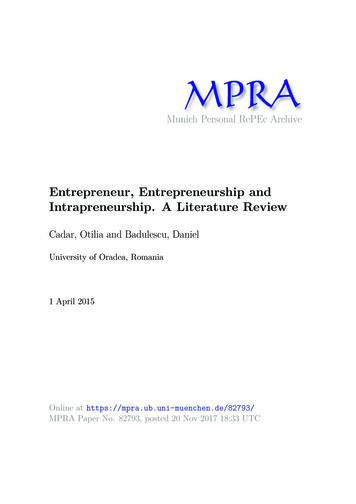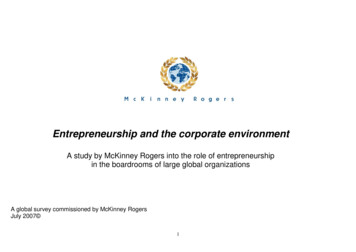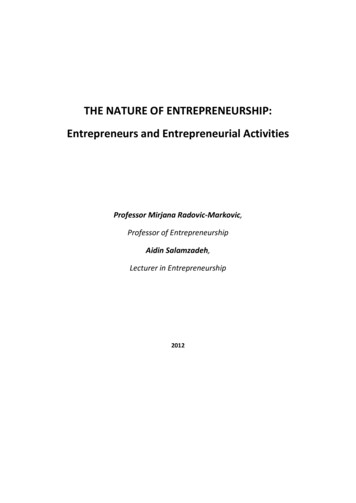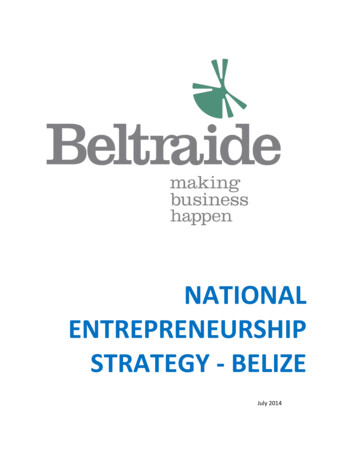
Transcription
NATIONALENTREPRENEURSHIPSTRATEGY - BELIZEJuly 2014
BELIZE S NATIONAL ENTREPRENEURSHIP TECHNICAL COMMITTEEThe Belize’s National Entrepreneurship Technical Committee is the arena for dialog andcoordination empowered to promote networking and entrepreneurship based on which thisStrategy for BELIZE has been designed and established in a joint manner. Below is a detail ofthe key actors that form part of this Committee, together with the names of therepresentative entities that led this process:Multilateral Investment Fund / IDBBELTRAIDEUniversity of BelizeEconomic Development CouncilBelize Chamber of Commerce & Industry
Employment training and educational servicesUWI, Open Campus, Belize
AcknowledgementsAgenciaPresidencialInternacional de ColombiaSandra Bessudo LionClaudia Rivero MedinadeCooperaciónMinistry of Trade, Industry and TourismSergio Zuluaga MartinezFernando Delgado RinconInternational ConsultantsWilliam Perez Cotrino – NEXUSSofia Victoria Higuera Quintero – NEXUSRosa Elena Martinez Ponce – NEXUSMaria Camila Patino Moreno-NEXUSJorge Isaac Murillo – NEXUSOscar Andres Ciro Toro – NEXUSCooperating PartnersDepartment of Foreign Affairs and TradeCentral America’s Regional Centre for the Promotion of MSMEsIngrid Figueroa SantamaríaVicente RivasCarmen CastroGovernment of the Republic of China (Taiwan)
ForewordHORIZON 2030 is Belize’s long-term developmentframework under the topic: Building a Resilient Economyto identify the high level goal, “A resilient economy with alevel playing field for all businesses and entrepreneursusing appropriate technology to increase productivity andcompetitiveness in an environmentally sustainable way.”Entrepreneurship is undoubtedly the most importantMr. Nicholas Ruiz, Executive Director,driver of innovation, job creator and economic growth, andBELTRAIDEit is crucial for growth and development of a formalized and vibrant small-and mediumsized business sector. Entrepreneurship enhances the productive sector and can be usedto find practical business solutions to some of our social and environmental challenges.BELTRAIDE, in collaboration with CENPROMYPE, the SICA-based regional Center for thePromotion of Micro and Small Enterprises, and the technical assistance from the APC, theColombian Presidential Agency for International Cooperation, the Ministry of Trade,Industry and Tourism; and Nexus, a Colombian based consultancy firm hired to facilitatethe methodology and process to develop the Regional and National Agendas forEntrepreneurship, has embarked on the development of a National EntrepreneurshipStrategy for Belize. This strategy builds on the aforesaid regional strategy that wasdeveloped for SICA countries and also builds on Belize’s MSME (Micro, Small and Mediumsized Enterprises) Policy that was developed in 2012. This strategy is a proactive approachby the Government of Belize and Belize’s private sector to support entrepreneurship: thestrategy outlines a systemic approach to address and correct some of the challenges thatentrepreneurs face as they attempt to build strong and sustainable business models.The strategy identified five pillars that are vital for the development of a strongentrepreneurial culture: Education, Support Industry, Financing, Institutional Articulationand Mentality and Culture. These pillars are similar to those identified in the NationalMSME Policy & Strategy where the pillars that formed the framework of that documentare: Legislative and regulatory frame-work; increased flow of capital; market access andcompetiveness; and education and training. A direct result of Belize’s MSME Policy &Strategy has been the development of the Small Business Development Center (SBDCBELTRAIDE) which over the past year has been instrumental in providing training andmentorship to entrepreneurs across the country. BELTRAIDE firmly believes that with theaid of these guiding documents we will be continue to build viable bridges to supportentrepreneurs country-wide by ensuring that the enabling environment and the factors
that foster growth are accessible to all. Henry Ford coins it best “Coming together is abeginning; keeping together is progress; working together is success. “I take this opportunity to thank CENPROMYPE, the Government of Colombia, APCColombia, the Ministry of Trade, Industry and Tourism of Colombia, and all thestakeholders in Belize for their contributions and l look forward to us working together toensure that this document becomes a living and breathing one.
TABLE OF CONTENTSINTRODUCTION1.BELIZE’S ENTREPRENEURSHIP STATE OF THE ART . 31.1Background of SICA EMPRENDE Strategy . 31.2Belize: Entrepreneurship, state of the art . 31.3Regulatory Framework . 71.4Domestic Institutionality . 91.5Diagnosis of the National Entrepreneurial Ecosystem . 111.6Conceptual Framework of the National Ecosystem . 221.7Problem Tree . 262.BELIZE’S ENTREPRENEURSHIP REFERENCE FRAMEWORK. 302.1Conceptual Framework . 302.2Targets . 342.3Think Centres and international trends . 383.BELIZE’S ENTREPRENEURSHIP PROMOTION STRATEGY . .473.1Belize’s Objectives, Purpose and Justification Strtategy . 473.2Ten Strategic Entrepreneurial Initiatives. 483.2.13.3Logical framework matrix. 523.3.14.Analysis . .50Logical Framework Matrix . 52CONCLUSIONS AND RECOMMENDATIONS . 564.1Conclusions . 564.2Recommendations . 575.ANNEXES . 656.BIBLIOGRAPHY. 77
LIST OF FIGURESFigure 1. How Belize and other comparable economies rank on the Doing Business report. 4Figure 2. How Belize ranks on Doing Business issues . 6Figure 3. Geographical Coverage of the Entrepreneurial Instruments . 12Figure 4. Nature of the Instrument . 12Figure 5.Type of Instrument . 13Figure 6. Type of Institution . 14Figure 7. Main aspects of the Regioal SICA Strategy. 14Figure 8. Instrument Approach . 15Figure 9. Focus by type of endeavor . 16Figure 10. Focus according to the entrepreneur’s seniority . 18Figure 11. Entrepreneurial instrument by stages of the entrepreneurship chain . 19Figure 12. Target entrepreneurial segments . 19Figure 13. Focus on financial instruments . 21Figure 14. New statistics necessary . 21Figure 15. Entrepreneurship Factors. 22Figure 16. Challenges for the ecosystem . 23Figure 17. Entrepreneurship in five years . 23Figure 18. Problem Tree . 27Figure 19. Relevant Components – Governance Analysis Matrix . 68Figure 20. Mobility-Dependence Matrix . 73TABLES INDEXTable 1. The relative position of Belize in the variable level . 7Table 2. Political and regulatory framework, Belize . 8Table 3. Entities coverage percentage for each stage of the entrepreneurial chain . 18Table 4. Unattended segments . 20Table 5. Value Chain . 32Table 6. Entrepreneurship axes in Barbados and Dominican Republic . 44Table 7. Strategic Initiatives: Belize. 49Table 8. Ecosystem Logical Framework. 52Table 9. Recommendations for the Ecosystem . 57Table 10. Recommendations for the Institutions . 58Table 11. Recommendations for the Programs . 59Table 12. Recommendations by axis . 60Table 13. Normative framework recommendations. 63Table 14. Tought tank axis 1. Support Industry . 65Table 15. Tought tank axis 2. Financing . 66Table 16. Tought tank axis 3. Articulation . 67Table 17. Tought tank axis 4. Mentality and Culture . 67Table 18. Tought tank axis 5. Education System . 68Table 19. Strategic Initiatives – IGO Matrix. 69Table 20. Results of the participant’s perception on control or governance over the ten factors . 70Table 21. Results Relevance-Governability Matrix . 70Table 22. Results of the participant’s perception on control or governance over the ten factors . 72
Table 23. Best practices by axis in reference countries . 74ILLUSTRATIONS INDEXIllustration 1. Focus According to the Entrepreneurship Type . 15Illustration 2. Focus by entrepreneurship types (instrument names) . 17Illustration 3. Current focus according to the entrepreneurial chain stages . 17Illustration 4. Entrepreneurship clasification . 30Illustration 5. Necessity driven entrepreneurship and its clasification. 31Illustration 6. Opportunity driven entrepreneurship and its clasification . 31Illustration 7. Ecosystem scope . 34Illustration 8. Open Government Diagram. 36Illustration 9. SICA Entrepreneurship policy pillars . 43
GLOSSARYVenture capital: "Is capital to finance growth, expansion and development of a company, from thestart-up of operations until that time in which the product or service is able to penetrate themarket and begin its expansion phase" (MINCIT, 2011).Pre-seed Capital: Is capital destined for early stage funding from the conception of the businessidea to the elaboration of the business plan, focusing specially in developing prototypes, markettests, patents and business equipment (CENPROMYPE, 2013).Seed capital: "Capital oriented to finance the first stage of a business; it is used to research, test,and develop an initial concept" (MINCIT, 2011)."The seed capital is the first stage of investment mainly dedicated to the financing ofentrepreneurship before the start of operations and to prepare the launching of the company, theinvestment focuses on making viable a business idea therefore it is considered to have a hightechnological, commercial, and financial risk exposure" (COLCIENCIAS, 2007).Entrepreneurial ecosystem: It is defined as a business community, supported by a context ofpublic laws and business practices, and formed by a foundation of interacting organizations andindividuals who produce and associate business ideas, skills, financial and non-financial resourcesresulting in dynamic companies (MIF, 2008).Entrepreneur: A person with capacity to innovate; this being understood as the capacity togenerate goods and services in a creative, methodical, ethical, responsible and effective manner(Colombian Congress, 2006).Entrepreneurship: A way of thinking and acting oriented to wealth creation in order to takeadvantage of the opportunities present in the environment or to meet the needs of personalincome generating value to the economy and society.Wealth: “It’s about the goods, services, values, relations, transactions, environments that allowmen and women in a society to live worthily and to be happy”.Deal Flow: It is the amount of business initiatives which are entering to the system in a given unitof time (MIF, 2008).Business Incubator: The National Business Incubation Association –NBIA defines it as a businesssupport process that accelerates the successful development of start-up and fledgling companiesby providing entrepreneurs with an array of targeted resources and services. These services areusually developed or orchestrated by incubator management and offered both in the businessincubator and through its network of contacts (NBIA, n.d.).Innovation: Innovation is assimilation and successful exploitation of a novelty in the economic andsocial fields, in such a way that it contributes with new solutions to national and regional problemsand thus allows to respond to the needs of society and the productive sector.
Open Innovation: Open innovation is a paradigm that assumes that firms can and should useexternal ideas as well as internal ideas and paths, internal and external to the market, sincecompanies seek to advance its technology (Chesbrough, 2003). The concept of open innovationcomes from the idea that companies are no longer able to deal with the whole process ofinnovation by themselves. They must have external resources (intellectual property, ideas,products, people, and institutions) that should be integrated into its own chain of innovation.Minimum Viable product: The minimum viable product is that version of a new product whichallows a team to collect the maximum amount of validated learning about customers with theleast effort. It is a strategy targeted at avoiding building products that customers do not want, thatseeks to maximize the information learned about the customer per dollar spent (Ries, 2011).Types of entrepreneurs by PhaseAccording to GEM (Babson College, 2014), There are four phases that make up the entrepreneurialprocess:i.Potential entrepreneursThese individuals believe they possess the capability to start a business, see new businessopportunities and would not be dissuaded from doing so for fear of failing. Additionally theirintention to start a business is underpinned by the perceptions society holds of entrepreneurs, thestatus these individuals enjoy in their society and whether the media positively representsentrepreneurs.ii.Nascent EntrepreneursIndividuals with new businesses that are less than three months old. Given the challengesassociated with starting a new business not all nascent entrepreneurs advance to the next stage,either as self employed or working simultaneously with another job.iii.New Business OwnersNew business owners are defined as those former nascent entrepreneurs who have been inbusiness for more than three months, but less than three and a half years (42 months) thusmaking salary payments to another employee or to the owner, either as self-employed orsimultaneously with another job.iv.Established businessesEstablished businesses are those that have been in existence for more than three and a half years.Entrepreneur SegmentsAccording with SICA Regional Entrepreneurial Strategy, the following fourteen (14) entrepreneursegments were defined, each one with different characteristics and needs (CENPROMYPE, 2013):1. High academic training entrepreneur:Researcher and graduate school. Researchers with commercial orientation developed inuniversities their own intellectual property or graduate school students’ business ideas, specially
backed by venture capital. They require Technological Transfer Offices, commercializationchannels, contact networks, managerial skills development, and business models.2. Established entrepreneur:Business owner that turns her/his
Wealth: Its about the goods, services, values, relations, transactions, environments that allow men and women in a society to live worthily and to be happy _. Deal Flow: It is the amount of business initiatives which are en
